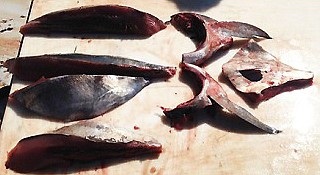 Facebook
Facebook
 X
X
 Instagram
Instagram
 TikTok
TikTok
 Youtube
Youtube

Beginning July 30, there are new Pacific bluefin tuna regulations for San Diego anglers, and rules on how fish can be filleted onboard boats. The regulations call for a reduction in bag limits, from ten bluefin to two.
The Magnuson-Stevens Fishery Conservation and Management Act, passed in 2006, will now regulate recreational tuna fishing in the “Exclusive Economic Zone” of California, basically Point Conception in Santa Barbara County, south to Mexican waters.
While regulations were written and issued federally by the National Marine Fisheries Service, a branch of NOAA, California’s Department of Fish and Wildlife’s game wardens will be charged with enforcement.
As of July 24, DFW states it has not completed its side-by-side changes in state law needed to comply with federal law, but both agencies say that local fishermen and boat operators are subject to enforcement beginning July 30.
The regulations also affect the way all tuna species are filleted aboard a boat, not just bluefin. The new regulations are required, says NOAA, so that game wardens can verify fish counts on board a vessel.
Online chatter by sportsmen over this issue seems to indicate DFW may use at-sea, boat-boarding inspections. DFW will probably also use “monitoring visibility,” use of binoculars from an unseen vantage point, as anglers get off the boat.

Onboard deckhands will now only be able to offer their fillet services by cutting tuna into six pieces, and keeping skin attached: four loins (two upper and two lower), belly fillet including the pelvic fins and urogenital vent, and the collar with pectoral fins attached. Each fish must be placed in its own bag and labeled with the species’ common name.
Those anglers wishing to have their tuna cut another way must keep the fish whole until off the boat. Anglers can also pay one of a couple San Diego fish processors to fillet their fish a special, nonregulated way.
Local processors include Sportsmen’s Seafood (also known as Mario’s) located next to the Seaforth Landing. Another processor, Five Star Processing, is about 15 minutes away from the Seaforth Landing. Both processors say a large charter can call ahead, even for overnight return trips, and they’ll have processors standing by.
Closer to Point Loma’s H&M Landing, returning fisherman will find Fishermen’s Processing nearby. North County anglers will unfortunately not find a fish processor near the Oceanside Harbor.


Beginning July 30, there are new Pacific bluefin tuna regulations for San Diego anglers, and rules on how fish can be filleted onboard boats. The regulations call for a reduction in bag limits, from ten bluefin to two.
The Magnuson-Stevens Fishery Conservation and Management Act, passed in 2006, will now regulate recreational tuna fishing in the “Exclusive Economic Zone” of California, basically Point Conception in Santa Barbara County, south to Mexican waters.
While regulations were written and issued federally by the National Marine Fisheries Service, a branch of NOAA, California’s Department of Fish and Wildlife’s game wardens will be charged with enforcement.
As of July 24, DFW states it has not completed its side-by-side changes in state law needed to comply with federal law, but both agencies say that local fishermen and boat operators are subject to enforcement beginning July 30.
The regulations also affect the way all tuna species are filleted aboard a boat, not just bluefin. The new regulations are required, says NOAA, so that game wardens can verify fish counts on board a vessel.
Online chatter by sportsmen over this issue seems to indicate DFW may use at-sea, boat-boarding inspections. DFW will probably also use “monitoring visibility,” use of binoculars from an unseen vantage point, as anglers get off the boat.

Onboard deckhands will now only be able to offer their fillet services by cutting tuna into six pieces, and keeping skin attached: four loins (two upper and two lower), belly fillet including the pelvic fins and urogenital vent, and the collar with pectoral fins attached. Each fish must be placed in its own bag and labeled with the species’ common name.
Those anglers wishing to have their tuna cut another way must keep the fish whole until off the boat. Anglers can also pay one of a couple San Diego fish processors to fillet their fish a special, nonregulated way.
Local processors include Sportsmen’s Seafood (also known as Mario’s) located next to the Seaforth Landing. Another processor, Five Star Processing, is about 15 minutes away from the Seaforth Landing. Both processors say a large charter can call ahead, even for overnight return trips, and they’ll have processors standing by.
Closer to Point Loma’s H&M Landing, returning fisherman will find Fishermen’s Processing nearby. North County anglers will unfortunately not find a fish processor near the Oceanside Harbor.
Comments